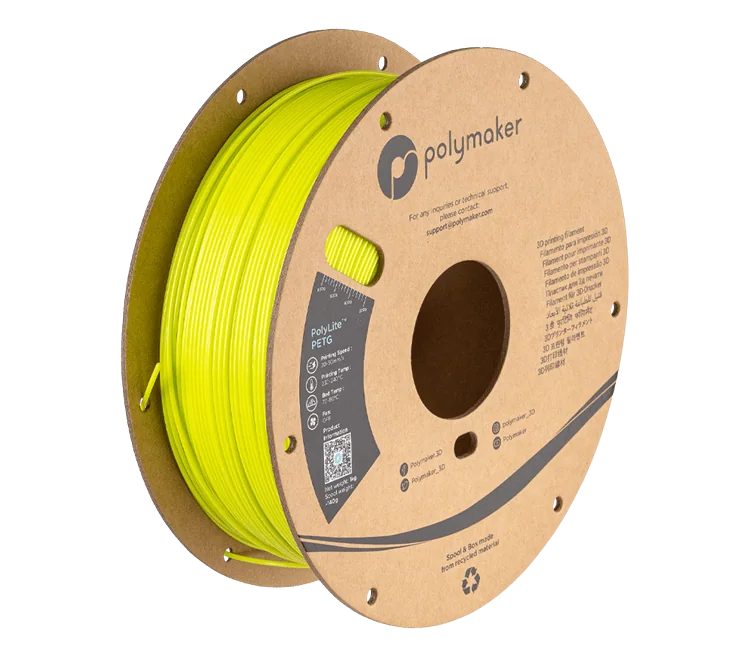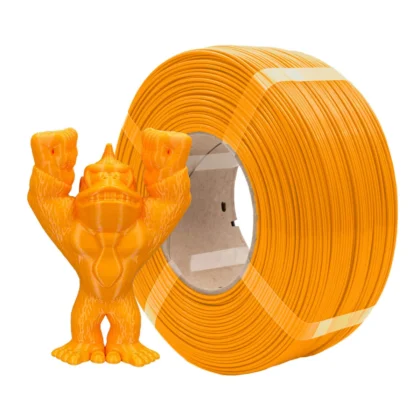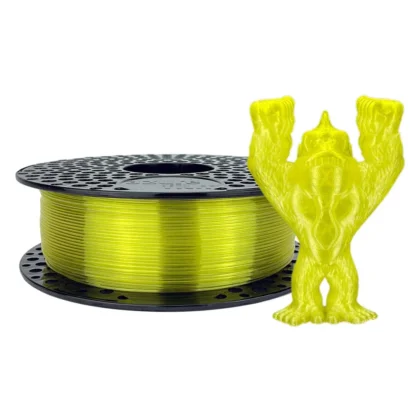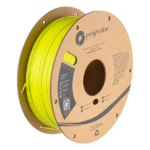PolyLite PETG – lime POLYMAKER
Features
High quality and heat resistant PolyLite™ PETG.
- High Quality PETG Polymaker.
- Good mechanical strength and durability.
- High heat resistance up to 78℃ HDT.
- Less deformation compared to other high temperature materials (ABS, ASA, PC).
- Consistent color and tolerance(1.75 mm diameter +/- 0.03 mm)
PolyLite™ is a family of 3D printing filaments manufactured from the finest raw materials to deliver exceptional quality and reliability. PolyLite™ covers the most popular 3D printing materials to meet your everyday design and prototyping needs. PolyLite™ PETG is an affordable PETG filament with balanced mechanical properties and affordable printer compatibility.
Properties
- Balanced mechanical properties – PolyLite™ PETG features well-balanced mechanical properties; it offers good strength while outperforming regular PLA in durability.
- Heat resistance – PolyLite™ PETG features heat resistance up to 80°C combined with good durability, enabling PolyLite™ PETG to be used for more functional applications where PLA will not have the durability or heat resistance, such as lighting fixtures, vibrating parts or more functional product design prototypes.
- Easy sanding – PolyLite™ PETG is easier to post-process than regular PLA, allowing it to be sanded to a nice smooth finish.
- Excellent compatibility – PolyLite™ PETG filament is compatible with a wide range of 3D printers; PETG shares many advantages of PLA, such as fantastic dimensional stability with minimal distortion compared to other high temperature materials. A heated bed with a temperature of 80°C is required.
- Uncompromising Quality – With Polymaker’s industry-leading quality control process and rigorous in-house testing, you can be confident that PolyLite™ PETG will produce beautiful, reliable and accurate printed parts.
Recommended print settings
| Nozzle temperature | 230°C – 240°C |
|---|---|
| Pad temperature | 70°C – 80°C |
| Surface material for construction | Works well with most building surfaces, e.g. glass, BuildTak®, etc. Rigid build plates are recommended over magnetic flexible plates. |
| Substrate surface treatment | Apply Magigoo original, PVA adhesive or EcoFixy to the building surface to improve bonding. |
| Inclogger | Not required, but helpful to keep out drafts and maintain a stable printing environment. If closed, on some printers it is recommended that the door or lid be open to prevent an overly hot environment. |
| Cooling fan | LOW for better surface quality OFF for better strength |
| Print speed | 30 mm/s – 50 mm/s |
| Retraction | Ideal retraction settings vary from printer to printer and depend on the host. Direct drive: 1 mm retraction distance at 20 mm/s retraction speed Bowden: 3 mm retraction distance at 40 mm/s retraction speed |
| Recommended filaments for support | Single extrusion: Self-support. Double extrusion: PolyDissolve™ S1 (PVA) can sometimes support some patterns depending on their geometry. |
The above printing recommendations are based on a 0.4 mm nozzle. Please note that ideal printing conditions may vary depending on your 3D printer settings. For high-speed 3D printers, be sure to increase the extrusion temperature to use higher print speeds.
PETG is a “sticky” material compared to regular PLA. When it comes to printing PETG, it is recommended to keep the filament dry and adjust the temperatures, draw and speeds to avoid excess material build-up on the nozzle.
For other printing tips on PolyLite™ PETG, contact us !
Specifications
| Weight | 1kg |
|---|---|
| Type of material | PETG |
| Density | 1.25 (g/cm3 at 21.5˚C) |
Compatibility
PolyLite™ PETG has been developed with compatibility in mind to print perfectly on a wide range of 3D printers equipped with a heated bed. PolyLite™ PETG, like other materials, is hygroscopic. This means that it is susceptible to absorbing moisture from the atmosphere, which can subsequently affect the quality and mechanical properties of the final prints. See “Storage and Drying” details below for instructions on protecting PolyLite™ PETG.
Of course, with thousands of unique 3D printer models on the market, we can’t guarantee that every filament type will work with every 3D printer. Experience with cutting tools and adjusting settings is always required to get the most out of a material. Before embarking on an ambitious project, we always recommend printing some known calibration tests to build up or make adjustments to the filament profile.
THERMAL PROPERTIES
| Values | Test method | |
| Glass transition | 81°C | DSC, 10°C/min |
| Heat deviation temperature | 0.45MPa – 78.4°C 1.8 MPa – 74.8°C |
ISO 75 |
| Vicat softening temperature | 84°C | ISO 306, GB/T 1633 |
MECHANICAL PROPERTIES
| Value | Method of testing |
|
| Jung’s module (X-Y) |
2,116.8 MPa | ISO 527, GB/T 1040 |
| Tensile strength (X-Y) |
50.8 MPa | ISO 527, GB/T 1040 |
| Tensile strength (Z) | 42.8 MPa | ISO 527, GB/T 1040 |
| Elongation at break (X-Y) | 8.4% | ISO 527, GB/T 1040 |
| Bending modulus (X-Y) | 1,898.5 MPa | ISO 178, GB/T 9341 |
| Bending force (X-Y) |
69.6 ± 0.8 MPa | ISO 178, GB/T 9341 |
| Sharpie impact strength (X-Y) |
2.6 ± 0.2 kJ/m2 | ISO 179, GB/T 1043 |
The typical values presented in the Polymaker data sheet are for reference and comparison only. Due to the nature of 3D printing, they should not be used for design specification or quality control purposes.
Storage and drying
All plastics are hygroscopic, meaning they absorb moisture from the air, which can affect the print quality and strength of printed parts. How quickly this absorption occurs depends on the material and the environment. PolyLite™ PETG polymer filaments are dried and packaged in a vacuum bag with desiccant to ensure the best print quality. When not in use, PolyLite™ PETG should be stored away from sunlight and sealed in the packaged resealable bag.
Although filaments can be dried, drying will accelerate the aging process of the plastic, making it more brittle over time. Preventing moisture from being absorbed by the filament in the first place is the best solution to keep your filament working to its maximum potential. For long-term storage, we highly recommend storing in a sealed container with a desiccant dryer that reduces relative humidity to 10-20% RH.
If you hear popping sounds and notice that the surface quality of your print is uneven or the color is not consistent, this is probably an indication that the filament has absorbed too much moisture. PolyLite™ PETG spools can be dried with a Polymaker PolyDryer™, or other filament dryer using power level 2. Alternatively, if you have a convection oven that is accurate at low temperatures, users can dry the filament in a preheated convection oven at 65˚C for up to 6 hours. Results may vary depending on the accuracy of your oven, so please use caution.
Frequently Asked Questions
Q: Is PETG printed just like PLA?
A: Most types of filaments are compared to PLA or ABS when discussing how they are printed. PETG does not print exactly like PLA, but it has more similar printing characteristics to PLA than ABS, especially when discussing deformation. Ultimately, how easily a material prints depends on the hardware and previous user experience. We typically find PETG to be a fickle material when it comes to adjusting surface quality settings, but most users find the transition from PLA to PETG to be easier than the transition from PLA to ABS when it comes to printing large parts. The main differences between PLA and PETG are that the heated bed is very important when printing PETG, the optimum printing temperatures are different and the housings can be more useful when printing certain geometries.
Q: Can PETG be printed on large scales without warping?
A: In terms of dimensional stability, PETG is easier to print than high temperature materials such as ABS. When using a desktop 3D printer, very large prints that would warp or crack with ABS can often be printed from PETG without these issues. Typically PETG can be printed at large scales without the need for a casing, but this can vary depending on the adhesion of the first layer, the heating and the heated bed. For 3D printers that do not uniformly heat the entire bed surface, an enclosure can be very useful. Enclosures can also help prevent drafts.
Q: Can PETG replace ABS?
A: Many users point to PETG as an excellent substitute for ABS, which is certainly true for some applications. When comparing regular PETG and regular ABS; ABS is still the stronger, stiffer, and more heat resistant filament, but many end users find PETG to be easier to print without warping. If users are not going to take advantage of the extra performance offered by ABS, the improved printability of PETG may make PolyLite™ PETG a suitable candidate.
Q: Do I need to rewind this filament if I want to use it with another spool?
A: We strongly recommend that you do not interfere with the product by rewinding.All Polymaker filaments are wound with tension but without strain. Rewinding completely rearranges the curvature of the coil and this tension over time can cause most plastics to catastrophically break. If for some reason your printer is blocked from mounting smaller than standard size spools, there may be safe print adapters or external mounting solutions available.















There are no reviews yet.